2019七年级英语上册 Unit 4 Food and Restaurants测试题1 (新版)冀教版
- 格式:doc
- 大小:155.00 KB
- 文档页数:9
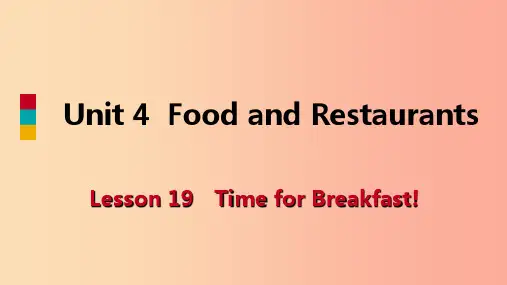
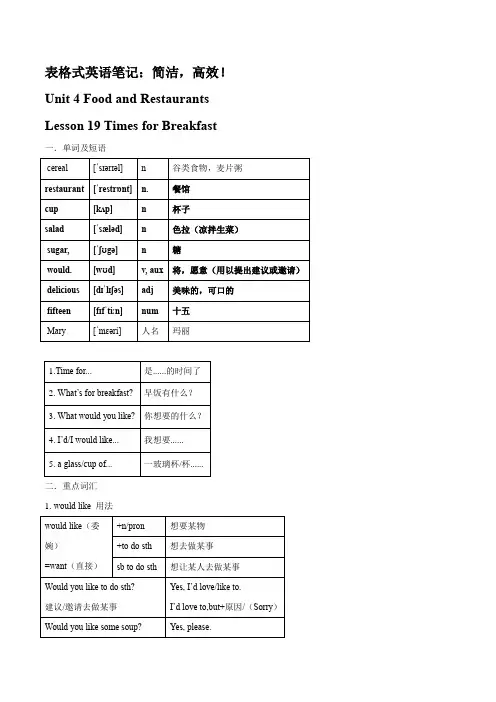
表格式英语笔记:简洁,高效!Unit 4 Food and RestaurantsLesson 19 Times for Breakfast一.单词及短语cereal [ˈsɪərɪəl] n谷类食物,麦片粥restaurant [ˈrestrɒnt] n.餐馆cup [kʌp]n杯子salad [ˈsæləd]n色拉(凉拌生菜)sugar,[ˈʃʊgə] n糖would.[wʊd] v, aux将,愿意(用以提出建议或邀请)delicious[dɪˈlɪʃəs] adj美味的,可口的fifteen [fɪfˈtiːn]num十五Mary[ˈmɛəri]人名玛丽1.Time for...是......的时间了2. What’s for breakfast?早饭有什么?3. What would you like?你想要的什么?4. I’d/I would like...我想要......5. a glass/cup of...一玻璃杯/杯......二.重点词汇1.would like 用法would like(委婉)=want(直接)+n/pron想要某物+to do sth想去做某事sb to do sth 想让某人去做某事Would you like to do sth? 建议/邀请去做某事Yes, I’d love/like to.I’d love to,but+原因/(Sorry)Would you like some soup?Yes, please.委婉征求对方意见。
No, thanks.2.带量词的不可数名词变复数a glass of water two glasses of water不可数名字变复数,只变量词。
3.put 短语put...on...把...放在...上put on your coat穿上大衣put up your hands举起手put off the exam 推迟考试put out the fire扑灭火put down the box放下盒子三.句型1.到了做某事的时间了句型汉意例句翻译It’s time for sb to do sth 到了某人做某事的时间了。
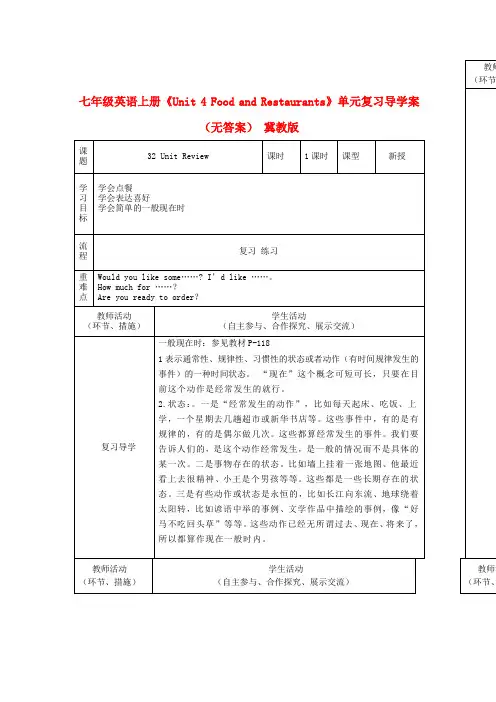
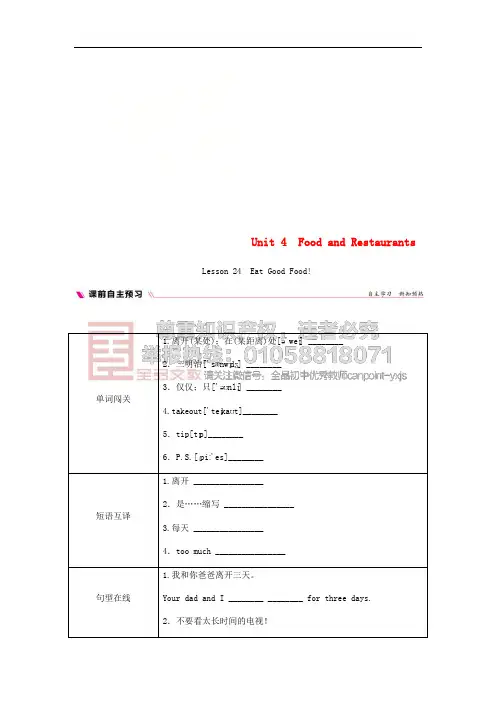
Unit 4 Food and RestaurantsLesson 24Eat Good Food!●1 Your dad and I are away for three days.我和你爸爸离开三天。
[探究] be away意为“不在;离开”,表示状态,后常跟“for+一段时间”作状语,表示“离开多长时间”。
其同义词为leave,但leave为非延续性动词,不能和一段时间连用。
[拓展] be away还可以表示“多远(的距离)”,若表示“离某地多远”,需在away后面加介词from,再接地点。
活学活用1.(1)我们离开五天。
We ________ ________ for five days.(2)我们家离学校有20米。
Our home ________ twenty metres ________ ________ the school.●2 Don't watch too much TV!不要看太长时间的电视![辨析] too much, much too与too many22活学活用2.(1)Tell him not to eat________ meat. It's bad for his health.A.too muchB.much tooC.too manyD.many too(2)I don't like winter because it's ________cold.A.too muchB.much tooC.far moreD.much more34 4详解详析【课前自主预习】单词闯关1.away 2.sandwich 3.only4.外卖食品 5.指点;提示6.附言;又及短语互译1.be away 2.be short for… 3.every day 4.太多句型在线1.are away2.watch too much3.is short for【课堂互动探究】句型透视●1 (1)are away(2)is; away from●2 (1)A (2)B【课时分层训练】课内基础自测Ⅰ.1.to watch/watching 2.sandwiches 3.only/just 4.tips 5.eatⅡ.1.is away 2.every day3.to get enough rest4.order takeout5.watches TV课后巩固提升Ⅰ.1.C 2.C 3.B4.C be short for意为“是……的缩写”。
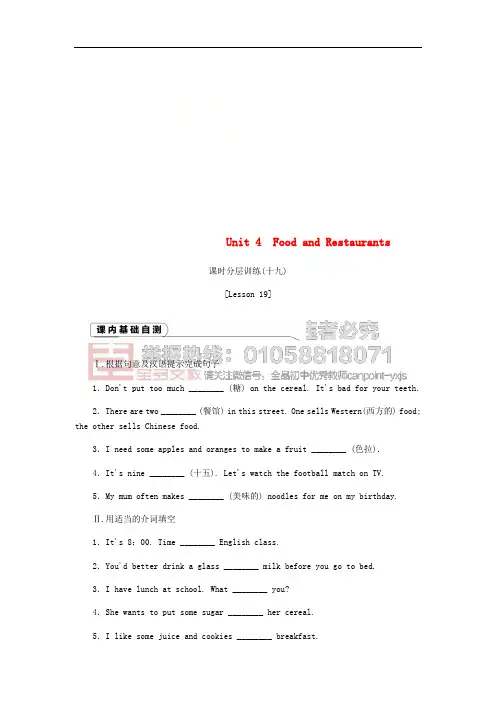
Unit 4 Food and Restaurants课时分层训练(十九)[Lesson 19]Ⅰ.根据句意及汉语提示完成句子1.Don't put too much ________ (糖) on the cereal. It's bad for your teeth.2.There are two ________ (餐馆) in this street. One sells Western(西方的) food; the other sells Chinese food.3.I need some apples and oranges to make a fruit ________ (色拉).4.It's nine ________ (十五). Let's watch the football match on TV.5.My mum often makes ________ (美味的) noodles for me on my birthday.Ⅱ.用适当的介词填空1.It's 8:00. Time ________ English class.2.You'd better drink a glass ________ milk before you go to bed.3.I have lunch at school. What ________ you?4.She wants to put some sugar ________ her cereal.5.I like some juice and cookies ________ breakfast.Ⅰ.单项填空( )1.I have ________ breakfast with my parents at home every day.A./ B.a C.an D.the( )2.Would you like ________?A.some bread B.some breadsC.any bread D.any breads( )3.It's time ________ lunch. I want________ some chicken.A.for; to have B.to; to haveC.for; have D.to; have( )4.—I'd like some cereal. ________ about you, Danny?—Me too.A.What B.WhenC.Why D.Where( )5. I like bread ________ breakfast, and I often put some jam ________ it.A.for; for B.on; onC.for; on D.on; for( )6.—Would you like some meat?—________. I'm on diet(节食).A.Yes, I like B.No, I don'tC.Yes, please D.No, thanks( )7.—________?—Yes, please. I want a pair of shoes.A.Can I help you22B.Do you want shoesC.What would you likeD.What's your favourite clothes( )8.Would you please pass me ________ sugar on the table?A.a B.an C.the D./( )9.—There is no sugar left at home. Greg, would you like to get ________?—OK!A.it B.one C.some D.any( )10.We're so thirsty. We would like ________.A.some chickenB.a milkC.two glass of watersD.two glasses of waterⅡ.任务型阅读Hello, everyone. I am Jenny. I am from Canada. Now I am in China with my family.I like China. I like Chinese food. I have breakfast at home. I have an egg, a piece of bread and a glass of milk for breakfast. I have no time to go home for lunch. So I have lunch in our school and the food is delicious. I can have different foods for lunch. I eat noodles,meat, cakes, fruit and vegetables. Sometimes I have dumplings. I have supper with my family at home.We usually have some vegetables and porridge(粥).根据短文内容,回答问题。
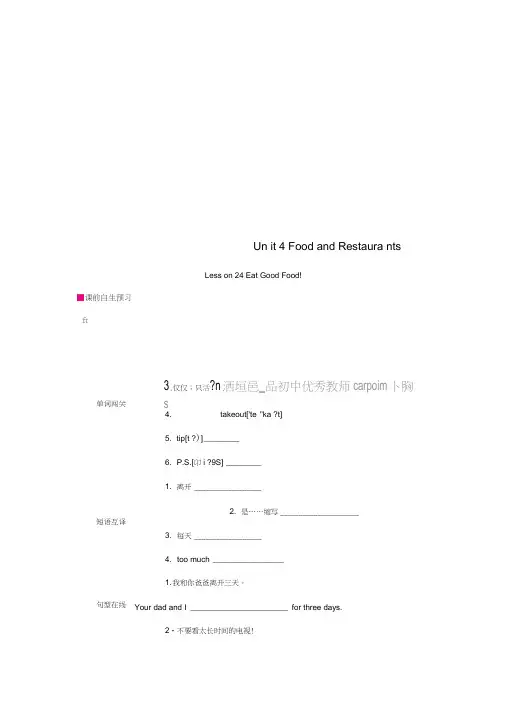
Un it 4 Food and Restaura ntsLess on 24 Eat Good Food!4. takeout['te "ka ?t]5. tip[t ?)] ________6. P.S.[卬i ?9S] ________1. 离开 __________________2. 是……缩写 _____________________3. 每天 __________________4. too much ________________1. 我和你爸爸离开三天。
Your dad and I ______________________ for three days.2•不要看太长时间的电视!■课前自生预习 ft 3.仅仅;只活?n 洒垣邑_品初中优秀教师carpoim 卜胸s 单词闯关 短语互译句型在线22Do n'tTV ! 3.例如,TV 是television 的缩写。
For example, TV televisi on.V 课堂互动探究• 1 Your dad and I are away for three days.我和你爸爸离开三天。
[探究]be away 表示“离开多长时间” 用。
1. (1)我们离开五天。
We ________________ for five days.(2)我们家离学校有20米。
Our home ________ t wenty metres _________________ t he school.• 2 Don't watch too much TV!不要看太长时间的电视![辨析]too much, much too 与 too many,需在?away 后r 请关注微信号:全品初中优秀教师canp 前侮活学活用[拓展]be away 还可以表示 面加介词from ,再接地点。
意为"不在;离开”,表示状态,后常跟"for +—段时间”作状语, 。
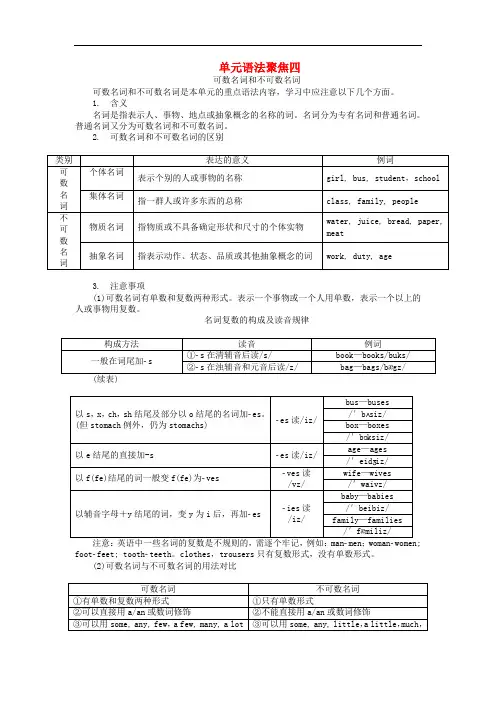
单元语法聚焦四可数名词和不可数名词可数名词和不可数名词是本单元的重点语法内容,学习中应注意以下几个方面。
1. 含义名词是指表示人、事物、地点或抽象概念的名称的词。
名词分为专有名词和普通名词。
普通名词又分为可数名词和不可数名词。
2. 可数名词和不可数名词的区别3. 注意事项(1)可数名词有单数和复数两种形式。
表示一个事物或一个人用单数,表示一个以上的人或事物用复数。
名词复数的构成及读音规律footfeet; toothteeth。
clothes,trousers只有复数形式,没有单数形式。
(2)可数名词与不可数名词的用法对比一般现在时:一般现在时表示经常性、习惯性的动作,或表示现在的特征、状态。
英语一般现在时态的句子中常出现的时间状语有: often 经常, usually通常, always 总是,every每个,sometimes 有时等等。
当主语是非第三人称单数时,行为动词的一般现在时变化形式(见下表)。
如:1.I usually _____ ______(起床) at six o’clock in the morning.2. He________(是) a worker in that factory.3. The Blacks(布莱克一家人) ________ ________(不吃) breakfast at seven every morning.4. Daniel and Thomas _______ (在) in Class Five,Grade One.5.We often_________(去) to the park on Sundays.6.Where ___you usually__have__(吃) lunch?7.________you_________(喝) tea every evening?8. My friends always__________(做) their homework after class.9. They_________(想要) some dumplings.10.—How________ you usually________(去) to school?—I usually ________(去) to school in my father’s car.1.get up_2.is_3.don’t_ have4.are5._go_6.do7.Do_ drink8._do9.want 10.do go。
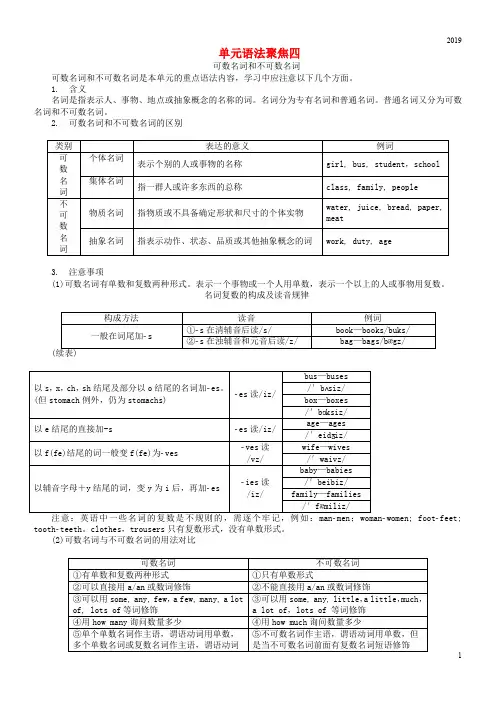
单元语法聚焦四可数名词和不可数名词可数名词和不可数名词是本单元的重点语法内容,学习中应注意以下几个方面。
1. 含义名词是指表示人、事物、地点或抽象概念的名称的词。
名词分为专有名词和普通名词。
普通名词又分为可数名词和不可数名词。
2. 可数名词和不可数名词的区别3. 注意事项(1)可数名词有单数和复数两种形式。
表示一个事物或一个人用单数,表示一个以上的人或事物用复数。
名词复数的构成及读音规律(toothteeth。
clothes,trousers只有复数形式,没有单数形式。
(2)可数名词与不可数名词的用法对比一般现在时:一般现在时表示经常性、习惯性的动作,或表示现在的特征、状态。
英语一般现在时态的句子中常出现的时间状语有: often 经常, usually通常, always 总是,every每个,sometimes 有时等等。
当主语是非第三人称单数时,行为动词的一般现在时变化形式(见下表)。
如:1.I usually _____ ______(起床) at six o’clock in the morning.2. He________(是) a worker in that factory.3. The Blacks(布莱克一家人) ________ ________(不吃) breakfast at seven every morning.4. Daniel and Thomas _______ (在) in Class Five,Grade One.5.We often_________(去) to the park on Sundays.6.Where ___you usually__have__(吃) lunch?7.________you_________(喝) tea every evening?8. My friends always__________(做) their homework after class.9. They_________(想要) some dumplings.10.—How________ you usually________(去) to school?—I usually ________(去) to school in my father’s car.1.get up_2.is_3.don’t_ have4.are5._go_6.do7.Do_ drink8._do9.want10.do go。
Unit 4 Food and RestaurantsⅠ.单项填空(共15小题;每小题1分,满分15分)1.My favourite food is rice ________ tomatoes and eggs.A.on B.in C.for D.with2.We don't have ________bread. Would you like ________ sandwiches, please?A.any; any B.some; someC.some; any D.any; some3. Jim, Kate and I ________ some donuts.A.are ready order B.is ready to orderC.ready to order D.are ready to order4.—I'm thirsty, Mum. Can I have ________?—OK. Here you are.A.something to buy B.something to drinkC.to eat something D.to drink something5.My friends eat dumplings ________ lunch. And they put vinegar(醋) ________ the dumplings. A.with; in B.of; on C.for; on D.at; in6.They would like four ________.A.glass of juice B.glasses of juiceC.glass juice D.glasses of juices7.—Sandy, please ________ these books ________the teachers' office.—OK.A.take; down B.put; aroundC.take; to D.pass; for8. It's time ________ to bed now.A.goes B.go C.to go D.going9.—I work out(算出) the difficult problem.—________.A.I don't know B.Good jobC.Let me look at it D.Let me see10.Let's go to the ________ to have lunch. The dumplings there are delicious. A.classroom B.libraryC.restaurant D.park11.Look!The small garden is ________beautiful flowers.A.different from B.full ofC.a bit of D.away from12.—________?—Yes, I'd like two hot dogs.A.Can I help you B.What do you want to buyC.What would you like D.Would you like some milk13. —Would you like some drinks, boys?—Yes, ________, please.A.some oranges B.two boxes of chocolateC.some cakes D.two cans of cola14.Everything in this shop ________ nice and beautiful.A.is B.are C.be D.has15.—________ a can of coke?—Three yuan.A.How many for B.How much areC.How many of D.How much forⅡ.完形填空(共10小题;每小题1分,满分10分)Man: Good morning. Can I help you?Boy: Yes, please. I want__16__ a computer.Man: Do you __17__ this one?Boy: __18__ is it made(制造)?Man: In the United States(美国).Boy:__19__ is it?Man: __20__ about 5,000 yuan.Boy: 5,000 yuan? That's too expensive(贵的). Do you have Chinese computers? Man: Yes, we __21__. These computers are made __22__ China.Boy: Well, this computer __23__ nice.Man: And it's about 4,000 yuan.Boy: Oh, __24__, I don't have so much money.Man: How about this one? It's only 3,500 yuan. It is from Shanghai.Boy: That's good. I'll __25__ it.16.A.buy B.buys C.buying D.to buy17.A.have B.like C.see D.know18. A.Where B.What C.How D.Whose19.A.How much B.How manyC.How tall D.How20.A.This is B.It'sC.They are D.These are21.A.are B.aren't C.do D.don't22.A.at B.on C.in D.to23.A. are B.likes C.look D.looks24.A.hello B.sorryC.thank you D.goodbye25.A.take B.takes C.to take D.takingⅢ.阅读理解(共10小题;每小题3分,满分30分)AHello. My name is Dalin. I am a waiter in Malan Restaurant. We have free(免费的) hot soup for you. You can come here at any time from 11:00 a.m. to 2:30 p.m. for lunch. Here is the menu.26. How much for a small hamburger and a large cup of coffee?A.17.50 yuan. B.16.50 yuan.C.16 yuan. D.15 yuan.27.John has 7 yuan. He can buy a small bowl of ________ and a large cup of ________.A.noodles; coffee B.dumplings; green teaC.fish; coke D.rice; pop28.A thirsty boy may want ________.A.some chicken B.a hamburgerC.a cup of coke D.some dumplings29.The underlined(画线的)word “menu” means “________”.A.地址 B.餐馆 C.菜单 D.菜谱30.What do we know from the passage?A.You can have lunch in the restaurant at 10:30 a.m.B.Dalin has a restaurant and the name is Malan.C.Two small glasses of pop and some hot soup are for six yuan.D.You can have some chicken in the restaurant.BMy name is Jim. I have a sister. Her name is Jenny. We are from Canada. We are in China now. We have many friends here. My sister and I like different things. I like Chinese food and my sister likes Chinese clothes. I like to eat rice, noodles and cakes. Noodles are my favourite food. I eat them for lunch or supper. I like the fruit here very much, too. I like peaches(桃子), pears, strawberries(草莓) and bananas. My sister likes to wear Chinese dresses, hats, socks and shoes. Her favourite colours are yellow and blue.Sometimes we go to McDonalds to eat a sandwich and French fries on Sundays. We feel very happy here!31.Jim and his sister ________.A.are in CanadaB.are from ChinaC.have many friends hereD.like the same thing32.Jim likes to eat ________.A.rice and cakesB.peaches and pearsC.strawberries and bananasD.A, B and C33.Jenny's favourite colours are ________.A.yellow and blue B.yellow and redC.blue and red D.green and blue34.Jim has ________ for lunch or supper.A.rice B.noodlesC.cakes D.dumplings35.Jim and Jenny feel ________ in China.A.happy B.sad C.tired D.scaredⅣ.任务型阅读(共5小题;每小题2分,满分10分)A Bite of China (《舌尖上的中国》)is a very popular(流行的) TV show in China. It is about Chinese food. In this show, we can see many kinds of food. We can also learn different ways(方法) of cooking food. Why is this show popular? Because this show is not only about Chinese dishes(菜肴), but also telling stories about Chinese people.Eating is very exquisite(讲究) in China. The Chinese think food is the gift from nature(自然). Chinese cuisine(烹饪) is an important part in our everyday life. It helps people around the world know about Chinese culture.36—37题完成句子;38题简略回答问题;39题找出文章的主题句;40题将文中画线句子译成汉语。